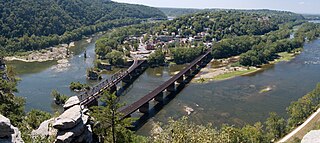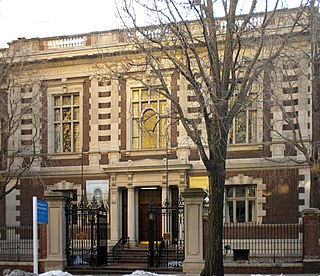
The Rengstorff House was one of the first houses to be built in Mountain View, California. It was built c. 1867 by Henry Rengstorff, a prominent local businessman who operated a ferry between San Francisco and Mountain View. It is built in the Italianate Victorian architecture style. The house's three-bay front facade features an entrance pavilion topped by a balustrade and a pediment on the middle bay.

Harpers Ferry National Historical Park, originally Harpers Ferry National Monument, is located at the confluence of the Potomac and Shenandoah rivers in and around Harpers Ferry, West Virginia. The park includes the historic center of Harpers Ferry, notable as a key 19th-century industrial area and as the scene of John Brown's failed abolitionist uprising. It contains the most visited historic site in the state of West Virginia, John Brown's Fort.

Lincoln Park is a city square and neighborhood, also known as "the Coast," in Newark, Essex County, New Jersey, United States. It is bounded by the Springfield/Belmont, South Broad Valley, South Ironbound and Downtown neighborhoods. It is bounded by Martin Luther King Jr. Blvd. to the west, West Kinney St. to the north, the McCarter Highway to the east and South St., Pennsylvania Avenue, Lincoln Park and Clinton Avenue to the south. Part of the neighborhood is a historic district listed on the New Jersey Register of Historic Places and the National Register of Historic Places. Lincoln Park as a street turns into Clinton Avenue toward the south and north edge of the park.

The Carnegie Free Library of Beaver Falls is a historic Carnegie library in the city of Beaver Falls, Pennsylvania, United States. Erected as Beaver County's first library building, it was financed by Andrew Carnegie and designed by a leading Pittsburgh architect in grand architectural style that helped to redefine the image of the typical Carnegie library. Numerous community organizations have used its space, which remains in continued use as a library, and it has been named a historic site.

This list is of the properties and historic districts which are designated on the National Register of Historic Places or that were formerly so designated, in Hennepin County, Minnesota; there are 190 entries as of April 2023. A significant number of these properties are a result of the establishment of Fort Snelling, the development of water power at Saint Anthony Falls, and the thriving city of Minneapolis that developed around the falls. Many historic sites outside the Minneapolis city limits are associated with pioneers who established missions, farms, and schools in areas that are now suburbs in that metropolitan area.

The William Trent House is a historic building located at 15 Market Street in Trenton, Mercer County, New Jersey. It was built in 1719 for William Trent and is the oldest building in Trenton. He founded the eponymous town, which became the capital of New Jersey. It has served as the residence for three Governors. The house was added to the National Register of Historic Places and listed as a National Historic Landmark on April 15, 1970, for its significance as an example of Early Georgian Colonial architecture.

The Wayne State University historic district consists of three buildings on 4735-4841 Cass Avenue in Midtown Detroit, Michigan: the Mackenzie House, Hilberry Theatre, and Old Main, all on the campus of Wayne State University. The buildings were designated a Michigan State Historic Site in 1957 and listed on the National Register of Historic Places in 1978.

The Universalist Society Meetinghouse is an historic Greek Revival meetinghouse at 3 River Road in Orleans, Massachusetts. Built in 1834, it was the only Universalist church built in Orleans, and is architecturally a well-preserved local example of Greek Revival architecture. The Meeting House is now the home of the Orleans Historical Society and is known as the Meeting House Museum. It was listed on the National Register of Historic Places in 1999.

Mount Clare, also known as Mount Clare Mansion and generally known today as the Mount Clare Museum House, is the oldest Colonial-era structure in the City of Baltimore, Maryland, U.S.A. The Georgian style of architecture plantation house exhibits a somewhat altered five-part plan. It was built on a Carroll family plantation beginning in 1763 by barrister Charles Carroll the Barrister, (1723–1783), a descendant of the last Gaelic Lords of Éile in Ireland and a distant relative of the much better-known Charles Carroll of Carrollton, (1737–1832), longest living signer of the Declaration of Independence and the richest man in America in his later years, also the layer of the First Stone of the new Baltimore and Ohio Railroad, just a short distance away in 1828.

This is a list of the National Register of Historic Places listings in Otter Tail County, Minnesota. It is intended to be a complete list of the properties and districts on the National Register of Historic Places in Otter Tail County, Minnesota, United States. The locations of National Register properties and districts for which the latitude and longitude coordinates are included below, may be seen in an online map.

The Plaza Apartments is a historic five-story apartment building located in the Central neighborhood of Cleveland, Ohio, United States. Built in 1901, it was designed by the architectural firm of Steffens, Searles & Hirsh, which built many middle-class apartment buildings in the Cleveland era around the turn of the twentieth century. It features a primarily brick facade; stone appears in the exterior, and the foundation is stone. It was added to the National Register of Historic Places on November 1, 1984, being included primarily for its architectural significance. Other historic buildings surround the Plaza Apartments: it was added to the Register as part of the "Upper Prospect Multiple Resource Area," and the Register-listed Jeremiah Ensworth House is located next door. Located just a quarter of a mile (400 m) from the Cleveland State University campus, the Plaza Apartments remains an active apartment building today, although named the "Plaza Suites."

The West Ward School is a historic school at 39 Prospect Street in Wakefield, Massachusetts. Built in 1847, it is the only surviving Greek Revival schoolhouse in the town. The building was listed on the National Register of Historic Places in 1989. It is now maintained by the local historical society as a museum property.

The College of Physicians of Philadelphia is the oldest private medical society in the United States. Founded in 1787 by 24 Philadelphia physicians "to advance the Science of Medicine, and thereby lessen human misery, by investigating the diseases and remedies which are peculiar to our country" and to promote "order and uniformity in the practice of Physick," it has made important contributions to medical education and research. The College hosts the Mütter Museum, a gallery of 19th-century specimens, teaching models, instruments, and photographs, as well as the Historical Medical Library, which is one of the country's oldest medical libraries.

Public School 17 is a historic school located at City Island in the Bronx, New York City. It was designed by architect C. B. J. Snyder (1860–1945) and built in 1897 in the Neo-Georgian style. A rear addition was built in 1930. It is a two-story, five-bay brick building on a high basement. It features a shallow wooden entrance porch with Doric order columns.

The Old Astoria City Hall, now known as the Clatsop County Historical Society Heritage Museum, is a historic building located in Astoria, Oregon, United States, that is listed on the National Register of Historic Places. The building served as the city hall of Astoria from 1905 until 1939. It was the first location of the Columbia River Maritime Museum, from 1963 to 1982, and has been the Heritage Museum since 1985.

The Dame School is a historic meeting house, school, and now local historical museum, on New Hampshire Route 152 in Nottingham, New Hampshire. The single story wood-frame Greek Revival structure was built in 1840 as a church; according to local legend, timbers from a 1740 church were used in its construction. Its main facade has a simple entrance topped by a transom window, and flanked by a pair of windows. The building is topped by a three-stage tower, whose second stage houses a belfry, and whose spire is topped by a weathervane in the shape of a quill pen. It was used as a meeting house until about 1878, with its dual use as a school beginning c. 1870. It was dedicated for academic use in 1878, after the local Universalist congregation which had been using for services, built its own dedicated building. This building is said to have acquired its distinctive weathervane as a gift in 1870 from schoolmaster Bartholomew Van Dame.

The Adams Gristmill Warehouse is a historic industrial building on Bridge Street in Bellows Falls, Vermont. Built about 1925 by Frank Adams & Co., proprietors of the Adams Gristmill, it is a well-preserved example of a functional railroad-related industrial warehouse. It was listed on the National Register of Historic Places in 1990.

The Vernon District Schoolhouse No. 4 is a historic school building at 4201 Fort Bridgman Road in Vernon, Vermont. Built 1848, it is a well-preserved mid-19th century brick district school, which now serves as a local historical museum. It was listed on the National Register of Historic Places in 2005.
The W. Hawkins Ferry House, or William Hawkins Ferry House, is a private house located at 874 Lake Shore Road in Grosse Pointe Shores, Michigan. It was listed on the National Register of Historic Places in 2019.

Engine House No. 6, also known as the East Franklinton Engine House, is a former Columbus Fire Department station in the East Franklinton neighborhood of Columbus, Ohio. The building was constructed in 1892, designed in the Romanesque Revival style by John Flynn. The station was decommissioned in 1966, and served as an electronics store from 1975 to 2014. It was listed on the National Register of Historic Places in 2016, accompanying planned renovations. The station has been planned to be sold since about 2016, originally to the Columbus Historical Society and Heritage Ohio, though the latter organization now plans to move to the Ohio History Center. The historical society acquired the building in November 2021, and is restoring it with plans to turn it into the city's first permanent local history museum.





















